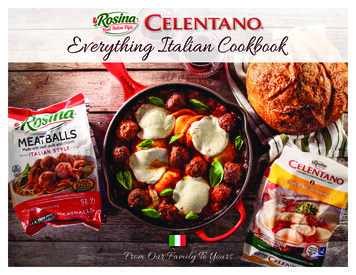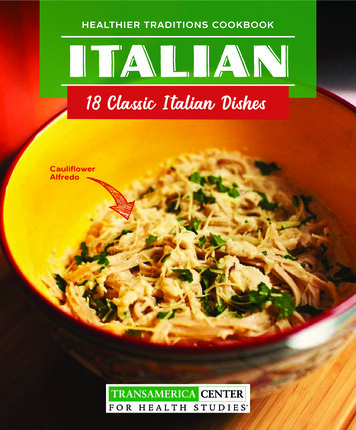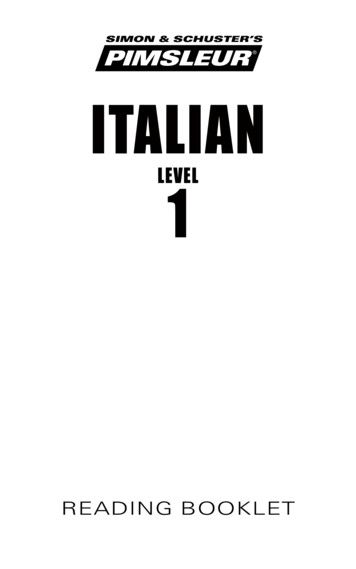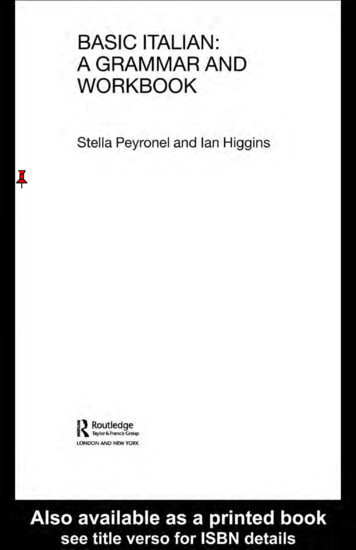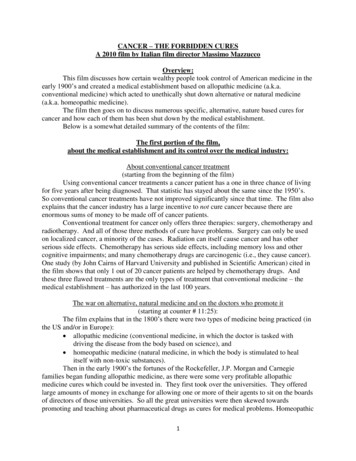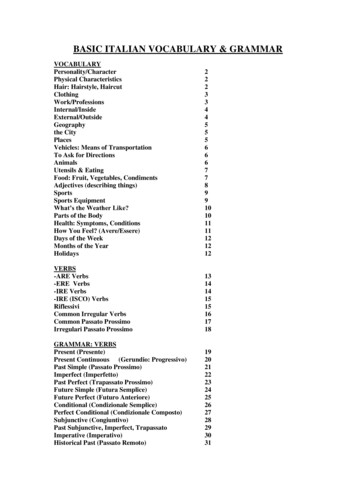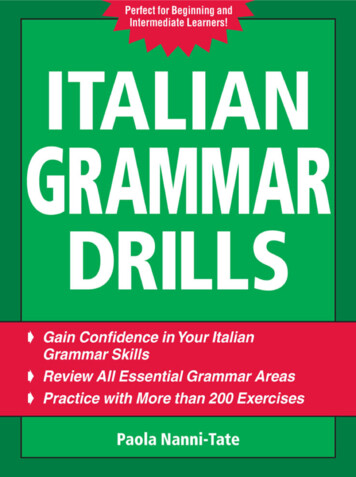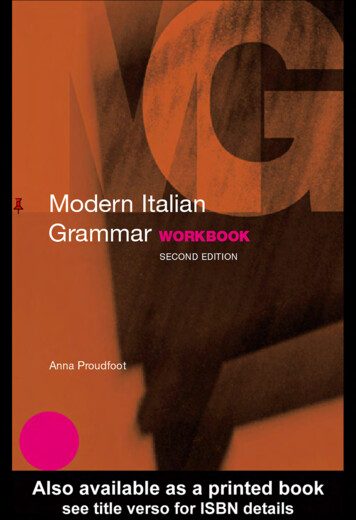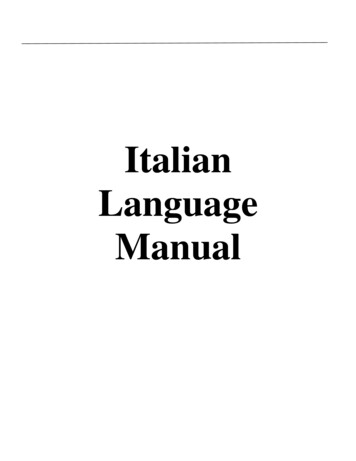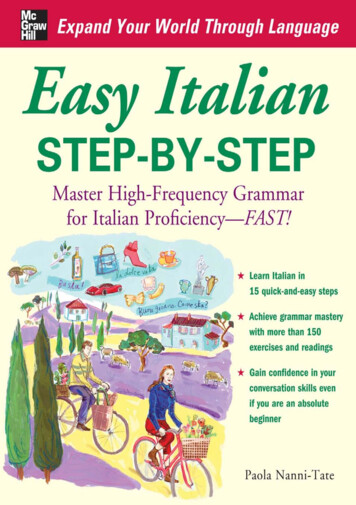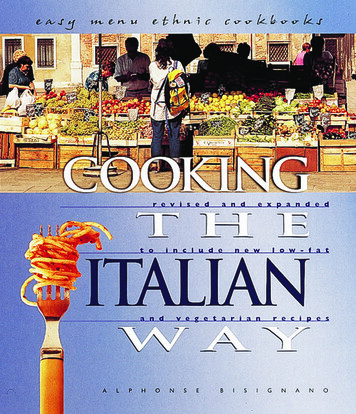
Transcription
Cookingt h eitalianw a y
Copyright 2002 by Lerner Publications CompanyAll rights reserved. International copyright secured. No partof this book may be reproduced, stored in a retrieval system,or transmitted in any form or by any means—electronic,mechanical, photocopying, recording, or otherwise—without the prior written permission of Lerner PublicationsCompany, except for the inclusion of brief quotations in anacknowledged review.This book is available in two editions:Library binding by Lerner Publications Company,a division of Lerner Publishing GroupSoft cover by First Avenue Editions,an imprint of Lerner Publishing Group241 First Avenue NorthMinneapolis, MN 55401 U.S.A.Website address: www.lernerbooks.comLibrary of Congress Cataloging-in-Publication DataBisignano, Alphonse.Cooking the Italian way / by Alphonse Bisignanop. cm. — (Easy menu ethnic cookbooks)Includes index.eISBN 0-8225-0516-91. Cookery, Italian—Juvenile literature. 2. Italy—Social life andcustoms—Juvenile literature. [1. Cookery, Italian. 2. Italy—Sociallife and customs.] I. Title. II. Series.TX723.B49 200200-009537641.5945—dc21Manufactured in the United States of America1 2 3 4 5 6 – JR – 07 06 05 04 03 02
easymenuethniccookbooksCookingr e v i s e da n de x p a n d e dt h et oi n c l u d en e wl o w - f a titaliana n dv e g e t a r i a nr e c i p e sw a yAlphonse Bisignanoa Lerner Publications Company Minneapolis, Minnesota
ContentsINTRODUCTION, 7An Italian TABLE, 27The Land and Its People, 8Regional Cooking, 9Holidays and Festivals, 11An Italian Market, 16An Italian Menu, 28BEFORE YOU BEGIN, 19The Careful Cook, 20Cooking Utensils, 21Cooking Terms, 21Special Ingredients, 22Healthy and Low-Fat Cooking Tips, 24Metric Conversion Chart, 25DINNER, 31Appetizer, 32Italian Salad Dressing, 33Minestrone, 35Chinese Pasta, 36Straw and Hay, 39Risotto, 40Spaghetti with Meat Sauce, 43Italian-Style Pork Chops, 44Chicken Hunter’s Style, 47
Bisignano Spinach, 49Italian-Style Cauliflower, 50Stuffed Pasta in Broth, 67Dead Bone Cookies, 68SUPPER, 53Index, 70Pizza, 54Biscuit Tortoni, 56About the Author, 72HOLIDAY AND FESTIVALFOOD, 59Bruschetta, 60Linguine with Pesto, 61Hot Cross Buns, 63Rice and Pea Risotto, 64
IntroductionThe words “Italian cooking” make many people think hungrily ofpizza, ravioli, and spaghetti smothered in tomato sauce. Juicytomatoes, cheese, and tasty noodles are certainly used often byItalian cooks. However, there is much more to Italian cuisine.Heritage and family are two of the most important ingredients inall Italian cooking. Gathering friends and family around the table toshare a meal is a highly valued part of social life in Italy. And just asevery region of this varied land has a culinary specialty, so doesevery household and kitchen.But as traditional as it is, Italian cooking is also very flexible. Mostdishes require only a few simple ingredients, and these may varyseasonally and even daily. Italian cooks like to shop every day toensure that their dishes include only the freshest, most flavorfulfoods. Whatever is available at the market—and looks the tastiest—will probably determine what is for dinner that day! As the recipesin this book show, colorful fruits and vegetables, olive oil, rice,and fresh herbs make Italian cooking as diverse as it is delicious.Antipasto is the perfect beginning for an Italian dinner, offering a variety of freshingredients to whet the appetite. (Recipe on page 32.)7
�· ·TuscanyRomeITALY·NaplesSardiniaMediterranean Sea·TrapaniSicilyThe Land and Its PeopleItaly is a boot-shaped peninsula that extends into the MediterraneanSea. The majestic Alps link Italy to the rest of Europe, and theApennine mountain range runs from the Tuscany region down to thepeninsula’s southern tip. Many valleys are located in these moun tains, and before modern transportation methods, the people wholived there were very isolated.The lack of communication among theItalian people made Italy a divided nation for a long time.8
Because the people of each region were loyal to their own arearather than to Italy as a whole, it was easy for other, more powerfulnations to take control of the Italian government. Italy passedthrough periods of Spanish, Austrian, and French rule beforebecoming an independent country. Not until 1861 did the Italianpeople become united under one ruler, Victor Emmanuel II.Even after this unification, however, regional differencesremained. The people of each region had developed their own waysof doing things—especially in the kitchen. They were very proud oftheir distinctive cooking styles and passed down their family recipesfrom generation to generation.Regional CookingNorthern and southern Italy are different from one another. Thenorth has very fertile land and a large, wealthy population, whilethe south has dry land and a smaller, poorer population. Thedifference in climate affects the ingredients available forcooking. This fact makes the dishes of northern and southern Italylook and taste distinct from each other. Each of Italy’s twentyregions has its own specialties, too.The northwestern region of Piedmont is known for its fragrantand sparkling wines, and its chief agricultural product is rice. Infact, it is the greatest rice-producing area in Italy, and Italy isEurope’s biggest producer of rice. The northeastern regions and thecity of Venice are also known for their rice dishes and for their fishdishes. Delicacies such as sole, anchovies, mackerel, eel, spinylobster, shrimp, and squid from the Adriatic Sea are cookedsimply so that their fresh flavor comes through.The northwestern region of Liguria also uses seafood in its cook ing, but it is best known for the use of fragrant herbs. Rosemary,basil, sage, marjoram, and others all decorate Liguria’s hillsides.These herbs add special flavors to the dishes of this area.9
Image Not AvailablePerhaps the richest cooking is in the north central region ofEmilia-Romagna, where butter is the main cooking fat. EmiliaRomagna’s specialties include homemade pasta (Emilia-Romagna isItaly’s largest producer of wheat), vegetables, fruit, hams, sausages,and rich dairy products, including Parmesan cheese. Bologna, thechief city of that region, is known as la grassa (the fat one). It spe cializes in delicious goose sausages and green lasagna. (For greenlasagna, spinach is added to the pasta dough.) Bologna’s mostfamous pork product is mortadella—a smoothly textured, delicatelyflavored sausage that can be as large as 18 inches around!10
South of Emilia-Romagna is the region of Tuscany, whose capitalis Florence. This region is known for its use of high-qualityingredients and a minimum of sauces and seasonings. It issimple home cooking at its best.Italian cooking changes once again south of the Tuscany region.The Apennine Mountains and foothills spread from coast to coast,and olive trees on the hillside replace the fat dairy cows of thenorth. Olive oil is the dominant cooking fat, and economical, massproduced, hard macaroni takes the place of soft, homemade pasta.The city of Naples is known for its pizza, made with thick redtomato sauce and creamy mozzarella cheese. Farther south, as the cli mate becomes warmer, vegetables have bright, vibrant colors, andpastas are so strongly flavored that a topping is often not needed.Heavy, rich sweets are also enjoyed in the south, particularly in Sicily.This island’s volcanic soil is excellent for growing citrus fruits, olives,and grapes.Holidays and FestivalsNo matter what region they come from, Italians love to celebrate. Inaddition to national holidays, nearly every village and city has itsown special festivals. Some festivals honor a patron saint (a saintwith special meaning to a particular city), while others celebrate ahistorical event or a local harvest. But one thing is common to all ofthese events: food.Easter, or la Pasqua, is the most important religious holiday forItaly’s many Roman Catholics. It is also a time to celebrate the arrivalof spring. Many people give their homes an especially good clean ing before Easter. Another custom is to buy new shoes and wearthem for the first time on Easter Sunday.Some cities have special Easter traditions. In Trapani, a town inSicily, a large procession begins at 2 P.M. on Good Friday (the Fridaybefore Easter Sunday) and lasts all night.Townspeople carry sculptures11
of the Virgin Mary and other religious figures through the streets,followed by large crowds. On Easter Sunday, a smaller paradeincludes a figure of Jesus to symbolize his rising from the dead. Thecity of Florence celebrates with a dramatic fireworks display onEaster Saturday. Pairs of white oxen, with their horns and hoovespainted gold, pull a decorated cart through town. In front of themain cathedral, a mechanical dove lights the fireworks on top of thecart. In Rome, thousands of people from all over the world crowdinto the square in front of St. Peter’s Basilica to hear the pope’s EasterSunday blessing.A variety of foods is associated with the Easter season. DuringLent, the period before Easter, most Italians do not eat certain foods,such as meat and rich desserts. On Good Friday, hot cross buns,which have a cross of white icing on top, are a popular snack.Simple meals of fish or pasta are usually eaten on Good Friday andEaster Saturday. But on Easter Sunday, most families eat a largemidday meal. Roast lamb is a traditional main course, representingspring and innocence. Eggs, barley, and wheat are also symbols ofspring and rebirth, so breads are a very important part of ItalianEaster celebrations. A sweet bread in the shape of a dove, called lacolomba pasquale, is a popular dessert. People also munch on tiny candylambs made of sugary almond paste. Hollow chocolate eggs withsurprises inside are given as presents to children and adults alike.On Easter Monday, known as Pasquetta, or “little Easter,” families gointo the countryside for picnics and fun.Natale, or Christmas, is another important holiday season in Italy.During Advent (a period beginning four Sundays beforeChristmas), many families make twelve different kinds of cookies,one for each of the twelve days of Christmas (December 25–January6). During the novena, the nine days before Christmas, shepherdsfrom the mountainous areas of the country often journey into citiessuch as Rome to play traditional holiday music on bagpipes. Romealso has a famous outdoor market in Piazza Navona, a large citysquare, where vendors set up stalls selling toys, gifts, and treats.12
Image Not AvailableShoppers snack on hot chestnuts, which are roasted over smallstoves and sold in paper cones.Many Italian cities have large fish markets where cooks can buythe fixings for the Christmas Eve fish dinner on December 24.Traditionally, families eat seven different kinds of seafood, includingeel, salted cod, squid, and clams. After the big Christmas Eve meal,kids play tombola, a game similar to bingo, until it’s time to go tomidnight Mass. On Christmas Day, families share another big meal.The menu varies among regions and households, but a typical dishis tortellini in broth. For dessert, many Italians enjoy panettone, aspecial Christmas cake made in Milan.The Christmas season ends on January 6, or Epiphany. This is thetraditional day to exchange gifts in Italy. La Befana, portrayed as anold woman with a broom, brings candy, sweet oranges, and toys togood children. She brings lumps of charcoal to naughty children.13
Other Italian holidays include Liberation Day, All Souls’ Day,New Year’s Eve, and New Year’s Day. Liberation Day, on April 25,commemorates the Allied victory in Europe at the end of WorldWar II in 1945. This holiday is especially important in Venicebecause it is also the feast day of Saint Mark, Venice’s patron saint.On this day, a dish called risi e bisi was traditionally served to thedoge, or leader, of Venice. The main ingredients in the dish—which people still eat on this holiday—are rice, to representprosperity, and peas, to represent spring.November 2 is All Souls’ Day, also called the Day of the Dead.Many Italians visit and decorate graves on this day. Perugia, a cityfamous for its chocolate, holds the Fair of the Dead, where vendorssell wares and sweets. In Sicily, shops sell sugary treats shaped likeskulls. Many families set an extra place at dinner on All Souls’ Day toremember friends and family members who have died.New Year’s Eve can be a messy holiday in Italy. As midnightapproaches, it is customary to get rid of last year’s junk—by throw ing it out the window! People may toss old shoes, lamps, or dishesinto the street. For good luck in the coming year, Italians eat lentils,which are symbols of wealth because of their coinlike shape. OnNew Year’s Day, people often exchange good-luck gifts of mistletoeand calendars. Lasagna is a typical main course for dinner.Unlike national holidays, which are recognized all over Italy, fes tivals are usually celebrated only by certain towns or regions. Forexample, the Palio is a traditional horse race in Siena each August16. The festival honors the city’s patron saint and dates back to theMiddle Ages. Siena is divided into contrade, or neighborhoods,which compete against each other in the Palio. The night before therace, the contrade hold elaborate good-luck feasts. The next day,each horse is blessed by a priest, and then a great pageant of trum pets, banners, and townspeople dressed in bright medieval cos tumes parades to the racetrack. The track runs around Piazza delCampo, Siena’s central square. Although the race is very short—it isusually over in less than two minutes—it can be quite dangerous.14
Mattresses pad the walls near sharp turns and steep hills, since rid ers are often thrown from their horses.Afterward, the winners of the Palio celebrate by se
Italian people made Italy a divided nation for a long time. 8 . Because the people of each region were loyal to their own area rather than to Italy as a whole, it was easy for other, more powerful nations to take control of the Italian government. Italy passed through periods of Spanish, Austrian, and French rule before becoming an independent country. Not until 1861 did the Italian people .
